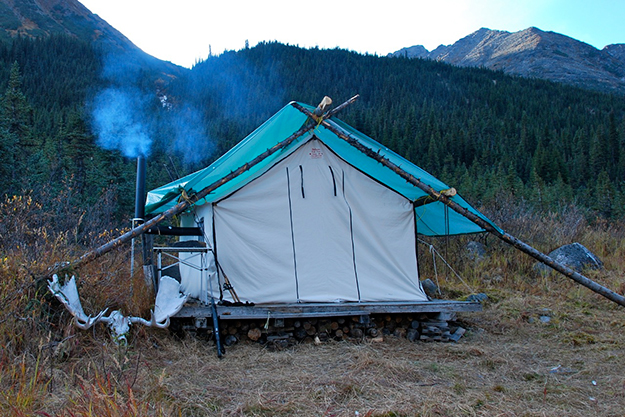Advertisement
So your non-camping significant other has finally agreed to spend a week in the backcountry, sitting around a fire, catching sunsets and enjoying the bounties of nature. But what about her (or his!) concerns about camping’s less desirable features? Namely, ravenous bugs, dank bedding and cramped quarters. Enter the traditional wall tent.
With ceilings high enough that you can stand upright, along with plenty of floor space, a wall tent can offer just the right balance of outdoorsy adventure and luxury. Sure, they’re cumbersome and you’ll need a pack animal or vehicle to get everything into the back of beyond, but it’s worth the effort. Done right, a week’s stay in a wall tent is never enough.
Advertisement
Set-up
Do yourself a favour and practise setting up and taking down the tent a few times before you head out. Many a camping experience has been ruined in the first half-hour when the tent just won’t cooperate. Include a fly in your set-up—the double roof will keep the tent cooler in summer, warmer in fall and drier all around. And if you extend the fly a dozen feet past the front of the tent, you’ll have a covered space for cooking, eating and lounging.
Flooring
The ultimate in luxury is to set the tent on a wooden platform, but that requires a load of lumber and a lot of hammering. An easier option is to lay down a sheet of poly tarp, cut to size, overtop the folded-in sod cloth (the flap sewn into the bottom of the walls). For added warmth, cover the tarp with outdoor carpeting or mill felt.
Heating
Bring a propane heater along as a hedge against those miserable rain days, even in summer. For cold-weather tenting, use an airtight wood stove rated to hold its heat for 10 hours so you won’t have to stoke the fire in the wee hours of the morning.
Advertisement
Bedding
A double air mattress works great, but don’t scrimp on quality; a cheaper model will inevitably develop a slow leak. Cover the mattress with a foam pad to insulate against the cold air. For bedding, zip two good sleeping bags together and line them with a cotton sheet. In chilly weather, cover the sleeping bags with a comforter tucked into a duvet cover.
Pest Control
Store your dishes, clothing and non-perishable food in sealable plastic totes to keep the vermin at bay. Keep your perishables in your vehicle or hang them in a bag out of reach of larger visitors. To make the tent bug-free, bring the likes of a ThermaCell or some mosquito coils.

